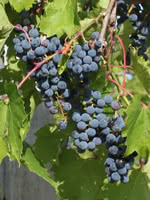Mon-Fri 9am - 5pm Mountain time
Frontenac Grape vs Grouseberry
Vaccinium scoparium
Vitis x Frontenac
CUSTOM GROW
NOT AVAILABLE THIS SEASON - MIGHT RETURN
Grouseberry is a native, low-growing deciduous shrub known for its edible red berries. In early summer, it produces small, urn-shaped flowers ranging from white to pink that attract bees and other pollinators. The berries provide an important food source for many types of wildlife, including game birds such as grouse, which gives the plant its common name. People can also enjoy the berries fresh or in baked goods, though they can be difficult to harvest in large quantities.
Spreading by rhizomes, Grouseberry forms dense, broom-like mats that help stabilize soil and prevent erosion, while also providing cover for ground-nesting wildlife. It is commonly found beneath conifers in open forests, subalpine meadows, and occasionally on rocky slopes in mountainous regions. It is well-suited for naturalization, ecological restoration, and soil stabilization projects.
Frontenac Grape is a prairie hardy climbing vine that produces juicy, flavorful grapes. Expect aromas of cherry, plum, and berry from the wine and juice you make from this grape.
Note: if you want grapes for fresh eating, you might want to look at Brianna or Valiant Grape.
This vine requires a fence or trellis to encourage upward and outward growth. Consistent pruning and maintenance is necessary to reliably produce fruit, which usually occurs between 3 and 4 years of age.
Note: We do not ship grape vines to BC due to regulatory restrictions from the Canadian Food Inspection Agency.

